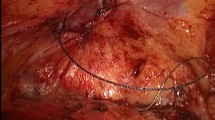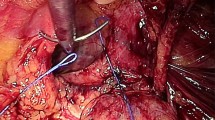Abstract
Background
Seroma are common early postoperative complications encountered in laparoscopic inguinal hernia repair. Previous anecdotal evidence from our surgical practice suggested a lower incidence of postoperative seroma formation with direct hernia repairs when the lax transversalis fascia (TF) is inverted by tacking to the pubic ramus. We undertook a study to investigate whether TF inversion in this way reduces the incidence of postoperative seroma.
Method
A total of 216 patients undergoing transabdominal preperitoneal (TAPP) laparoscopic inguinal hernia repairs from August 2003 to December 2005 were included in this prospective non-randomised controlled study. Surgeon 1 would routinely invert the TF whereas surgeon 2 would not. At follow-up the presence of postoperative seroma and pain was recorded.
Results
Mann–Whitney U test demonstrated no significant difference in terms of age, sex and time to follow-up between the surgeons’ patient groups (P > 0.05), and Chi-square test demonstrated significantly that inversion of the TF is associated with a lower incidence of postoperative seroma (P < 0.05). There was no significant difference in terms of postoperative pain at follow-up.
Conclusion
Inversion of the TF is associated with a statistically lower incidence of postoperative seroma, without increasing postoperative pain despite the use of one or two additional tacks.

Similar content being viewed by others
References
Cihan A, Ozdemir H, Ucan BH, Acun Z, Comert M, Tascilar O, Cesur A, Cakmak GK, Gundogdu S (2006) Fade or fate. Seroma in laparoscopic inguinal hernia repair. Surg Endosc 20:325–328
Litwin DE, Pham QN, Oleniuk FH, Kluftinger AM, Rossi L (1997) Laparoscopic groin hernia surgery: the TAPP procedure. Transabdominal preperitoneal hernia repair. Can J Surg 40:192–198
Sayad P, Hallak A, Ferzli G (1998) Laparoscopic herniorrhaphy: review of complications and recurrence. J Laparoendosc Adv Surg Tech A 8:3–10
Kapiris A, Brough WA, Royston CM, O’Boyle C, Sedman PC (2001) Laparoscopic transabdominal preperitoneal (TAPP) hernia repair. A 7-year two-center experience in 3017 patients. Surg Endosc 15:972–975
Keidar A, Kanitkar S, Szold A (2002) Laparoscopic repair of recurrent inguinal hernia. Surg Endosc 16:1708–1712
Lau H, Lee F (2003) Seroma following endoscopic extraperitoneal inguinal hernioplasty. Surg Endosc 17:1773–1777
Horstmann R, Hellwig M, Classen C, Rottgermann S, Palmes D (2006) Impact of polypropylene amount on functional outcome and quality of life after inguinal hernia repair by the TAPP procedure using pure, mixed, and titanium-coated meshes. World J Surg 30:1742–1749
Bittner R, Sauerland S, Schmedt CG (2005) Comparison of endoscopic techniques vs. Shouldice and other open nonmesh techniques for inguinal hernia repair: a meta-analysis of randomized controlled trials. Surg Endosc 19:605–615
Schmedt CG, Sauerland S, Bittner R (2005) Comparison of endoscopic procedures vs Lichtenstein and other open mesh techniques for inguinal hernia repair: a meta-analysis of randomized controlled trials. Surg Endosc 19:188–199
Leibl BJ, Schmedt CG, Kraft K, Ulrich M, Bittner R (2000) Scrotal hernias: a contraindication for an endoscopic procedure? Results of a single-institution experience in transabdominal preperitoneal repair. Surg Endosc 14:289–292
O’Riordain DS, Kelly P, Horgan PG, Keane FB, Tanner WA (1999) Laparoscopic extraperitoneal inguinal hernia repair in the day-care setting. Surg Endosc 13:914–917
Park A, Birch DW, Lovrics P (1998) Laparoscopic and open incisional hernia repair: a comparison study. Surgery 124:816–821
Susmallian S, Gewurtz G, Ezri T, Charuzi I (2001) Seroma after laparoscopic repair of hernia with PTFE patch: is it really a complication? Hernia 5:139–141
Classe JM, Berchery D, Campion L, Pioud R, Dravet F, Robard S (2006) Randomized clinical trial comparing axillary padding with closed suction drainage for the axillary wound after lymphadenectomy for breast cancer. Br J Surg 93:820–824
Moore M, Burak WE Jr, Nelson E, Kearney T, Simmons R, Mayers L, Spotnitz WD (2001) Fibrin sealant reduces the duration and amount of fluid drainage after axillary dissection: a randomized prospective clinical trial. J Am Coll Surg 192:591–599
Coveney EC, O’Dwyer PJ, Geraghty JG, O’Higgins NJ (1993) Effect of closing dead space on seroma formation after mastectomy––a prospective randomized clinical trial. Eur J Surg Oncol 19:143–146
Author information
Authors and Affiliations
Corresponding author
Rights and permissions
About this article
Cite this article
Reddy, V.M., Sutton, C.D., Bloxham, L. et al. Laparoscopic repair of direct inguinal hernia: a new technique that reduces the development of postoperative seroma. Hernia 11, 393–396 (2007). https://doi.org/10.1007/s10029-007-0233-4
Received:
Accepted:
Published:
Issue Date:
DOI: https://doi.org/10.1007/s10029-007-0233-4




